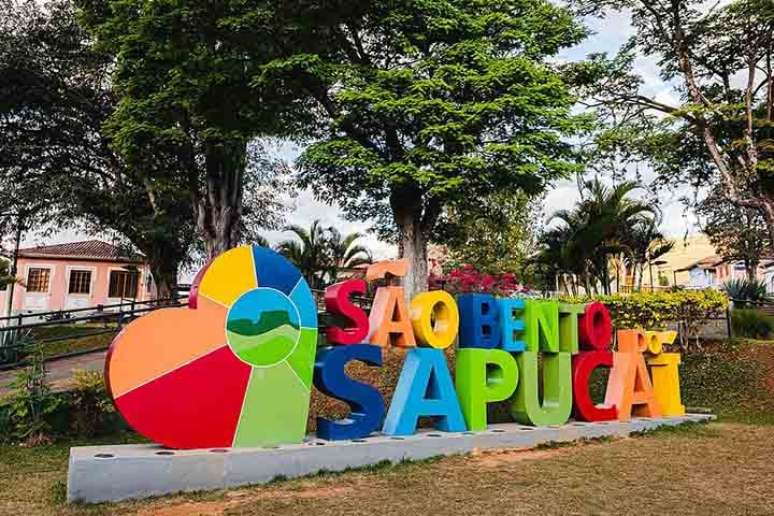-
Located in the Serra da Mantiqueira region, 185 kilometers from São Paulo, São Bento de Sapucaí is known as the “Brazilian Tuscany”. There are real delights there such as wines, cheeses, beers and olive oils and it is a high, cold region, suitable for growing grapes.
Photo: São Bento do Sapucai /wikimedia Commons/Flipar
-
The city is also famous for the Pedra do Baú, which receives visitors every day to enjoy the view from an altitude of 1,950 meters. It is therefore located in a conservation unit and presents a set of gneissic rocks.
Photo: Rodrigorosa85/ikimédia Commons / Flipar
-
The Pedra do Baú Natural Monument has 3,154 hectares and two other visit points, in addition to the main one: Bauzinho and Ana Chata. There, in addition to hiking trails and climbing, tourists can enjoy a free flight tour, as well as bird watching and abseiling.
Photo: Instagram @turismosaobentodosapucai / Flip
-
The walk to the top of Pedra do Baú takes approximately 3 hours and features numerous climbs. It begins with a path to the top of the base, continues with the 600 steps of the “via ferrada” and, in total, has 4 km of activities.
Photo: Instagram @saobentodosapucai / Flip
-
The Pedra Ana Chata trail has an estimated travel time of two hours. The via ferrata is also used, but a little shorter (3.8 km), as well as a section inside a cave.
Photo: Instagram @turismosaobentodosapucai / Flip
-
On both climbs the presence of guides is not mandatory, but safety equipment (seat, safety belts, connection carabiners and helmet) and planning are required.
Photo: Instagram @saobentodosapucai / Flip
-
There is also the Villa Santa Maria winery, whose 90 hectares welcome around 55 thousand tourists a year and currently contain 70 thousand vines producing winter wines.
Photo: Disclosure / Flip
-
Among the wines produced by Vinícola Villa Santa Maria are Chardonnay, Cabernet Sauvignon, Cabernet Franc, Sauvignon Blanc, Merlot, Syrah and Viognier.
Photo: – Instagram/Casas Baú’au / Flipar
-
Another important factor is the presence of Oliq, a producer of olive oil. With more than 10,000 olive trees of different types, the area can be visited for R$59 per person, including the view of the plantations and machinery.
Photo: Instagram @oliq_azeite / Flip
-
Furthermore, it includes tastings of nine different types of olive oil, both pure and mixed with desserts, fruit and bread.
Photo: Leandro Maranghetti Lourenço/Wikipedia / Flipar
-
Visitors can see the plantations and take photos of the olives still on the tree, despite the delicate nature of the olive grove. After all, any contact with the earth or a wrong choice of the olive ripening process can compromise the liquid.
Photo: São Bento do Sapuca/wikimédia Commons / Flipar
-
Surrounded by the Serra da Mantiqueira mountains, the place presents an internal landscape with a bucolic air and natural charm, such as waterfalls, fertile soil and climate. It is also a famous destination for rural tourism, sustainable ecotourism and wine tourism.
Photo: Instagram @saobentodosapucai / Flip
-
Cultural, gastronomic and historical tourism is also sought after thanks to the fact that the municipality preserves its architecture and culture (quilombola and caipira) in museums, churches and neighborhoods. Places marked by the rural customs of the 20th century, as well as the typical cuisine of the interior of São Paulo.
Photo: Municipality of São Bento do Sapucaí – SP / Flipar
-
São Bento do Sapucaí is the friendliest destination in Brazil, according to the Traveler Review Awards 2024, as well as being the third most sustainable city in the country.
Photo: Nilton Dantas Reis Junior /wikimedia Commons/Flipar
-
São Bento do Sapucaí is one of the 12 municipalities of São Paulo considered health resorts by the State of São Paulo, since they meet certain prerequisites defined by state law. This status guarantees these municipalities greater funding from the State to promote regional tourism.
Photo: – Ronaldo.smithjr/wikimédia Commons/Flipar
-
The history of São Bento do Sapucaí dates back to the beginning of Bandeirantism, when the inhabitants of São Paulo from Taubaté explored the Serra da Mantiqueira in search of the gold-bearing regions of Minas Gerais, following the course of the Sapucaí River.
Photo: Municipality of São Bento do Sapucaí – SP / Flipar
-
However, territorial disputes between the residents of São Paulo and those of the Captaincy of Minas Gerais marked the first years of occupation. Lieutenant José Pereira Alves, a prominent figure among the farmers of the region, was the founder of the city.
Photo: São Bento do Sapucaí City Hall – SP / Flipar
-
The need for religious assistance led Pereira Alves to donate land for the construction of a chapel. He brought Father Júlio Velho Columbreiro, from Pindamonhangaba, who blessed the place where the Church of Our Lady of the Rosary now stands, erecting a cross of the Redemption and a flag with the inscription
Photo: São Bento do Sapucaí City Hall – SP / Flipar
-
The city developed, being elevated to the rank of Parish in 1832, and then to Municipality, with the name of São Bento do Sapucaí Mirim, in 1858. It became a city and seat of the municipality on 30 March 1876, with the name of São Bento do Sapucaí.
Photo: Municipality of São Bento do Sapucaí – SP / Flipar
-
In March 1888, the municipality became news before the Lei Áurea. The president of the municipal council, Francisco das Chagas Esteves Salgado, together with a committee of prominent personalities of the region, summoned the local farmers for a unique ceremony.
Photo: Municipality of São Bento do Sapucaí – SP / Flipar
-
In this demonstration, which took place on March 11, 1888, farmers were asked to sign letters of manumission, thus freeing the slaves who worked on their properties; This marked the beginning of the emancipation of slaves in the municipality of São Bento do Sapucaí.
Photo: Municipality of São Bento do Sapucaí – SP / Flipar
-
During the Constitutionalist Revolution of 1932, São Bento do Sapucaí played a significant role, serving as a theater of fighting between São Paulo and Minas Gerais. Volunteers positioned themselves in trenches on the border of the states, resisting the advance of the Getulista troops.
Photo: São Bento do Sapucaí City Hall – SP / Flipar
-
The name of the city and the municipality is linked to the Sapucaí River, whose meaning in the indigenous language is “screaming river”. The feast of the patron saint, São Bento, celebrated on 11 July, is a traditional event that gains importance every year.
Photo: Levizoca /wikimedia Commons/Flipar
-
Its churches and old houses are at the same time simple, welcoming and beautiful. The Mother Church of the city was inaugurated in 1916, its works lasted more than 50 years.
Photo: São Bento do Sapucaí City Hall – SP / Flipar
-
The city has great influence from the quilombola communities, especially in culture and art. The main example is the historic Bairro do Quilombo, which has maintained its characteristics since its foundation in 1888, when at the time it was inhabited by former slaves.
Photo: Reproduction from Facebook Municipality of São Bento do Sapucaí – SP / Flipar
Share
Source: Terra
Rose James is a Gossipify movie and series reviewer known for her in-depth analysis and unique perspective on the latest releases. With a background in film studies, she provides engaging and informative reviews, and keeps readers up to date with industry trends and emerging talents.







